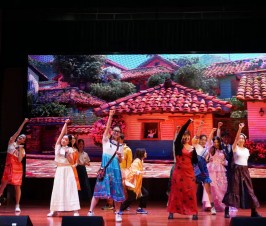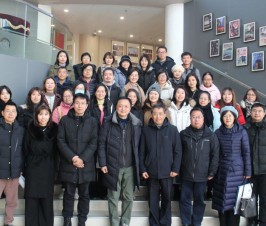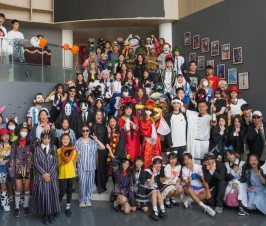Spring breeze brings warmth and renews everything. The overseas students’ Chinese style exhibition in Pudong, Shanghai was in full swing, with the theme “Stories of the Forbidden City”. In early March, teachers and students from the International Division of No. 2 High School of ECNU attended lectures by experts on the history of the Forbidden City and gained a lot. Inspired by the lectures, the students enthusiastically signed up for the themed speech competition, telling their own stories about the Forbidden City from different perspectives.
Hu Xinyu, from an architectural perspective, showcased the grandeur and magnificence of the Forbidden City. Here is what she said.
The Forbidden City is a model of the ancient Chinese architecture and an important symbol of the Chinese culture and history. Its architectural style and external structures are truly beautiful, showing the aesthetics and construction principles of the traditional Chinese architecture, taking the “pyramid principle”, “symmetry principle”, and “main axis layout” for example. It also incorporates elements of the traditional Chinese culture and art, such as carvings, paintings, and porcelain tiles. If you have the opportunity to visit Beijing, you must experience the historical and cultural charm embodied in this architectural complex.
Zhu Fangxian showed us some innovative designs of the Forbidden City’s buildings.
The roofs of every building in the Forbidden City are covered with yellow glazed tiles, presenting a magnificent and solemn appearance with its red walls and golden roof. However, after more than 600 years, how can the roofs still maintain their shining purity? It is because, in the design and construction process, the width of the ridges was designed according to the distance between bird’s toes, making it impossible for birds to grasp the tiles on the roof. Besides, the steep slope of the roof prevents birds from standing on it according to their physiological balance characteristics. The smooth and bright tiles are so flat that even occasional uninvited guests can fall off like leaves and dust. This clever and environment-friendly design is called the Eagle Does Not Land on the Roof design.
Lin Ruiyan’s narration was like a paintbrush, adding colors to the Forbidden City.
The beauty of the Forbidden City lies in its red walls, yellow glazed tiles, vermilion doors, and dazzling colors. The primary colors of the Forbidden City are yellow, black and green, along with various color combinations. According to the feudal system, yellow glazed tiles were used on the roofs of individual buildings in the Forbidden City to symbolize that the “earth” of the central imperial power is yellow, representing nobility and symbolizing that “there is no land under the sky that is not the emperor’s”. Under the blue sky unique to Beijing, there are rows of sparkling golden glazed tile roofs, green-colored decorative paintings under the roof, rows of red columns, doors and windows under the eaves, and the entire palace is located on a white stone platform with a dark gray brick floor below. The Forbidden City cleverly combines and applies various colors to create a strong sense of grandeur and magnificence. Color, light and space constitute the aesthetic beauty of the Forbidden City.
Luo Zhilin introduced to us about the mythical creatures on the ridges of the palace buildings. She told us about the following.
These auspicious birds and beasts have maintained the same pose for hundreds of years, representing the symbolism of warding off evil spirits and welcoming good fortune. The ten creatures on the roof of the Taihe Palace are named dragon, phoenix, lion, heavenly horse, seahorse, xia fish, suanni, xiezhi, bull and sheep. Like beautiful little elves, they have faithfully guarded the palace buildings for centuries through dynastic changes and weathering, forming a unique landscape of the eaves with the style of the ancient Chinese architecture.
Li Youting carefully counted the vast collection of artifacts in the Forbidden City, which almost covers the entire development process of the Chinese civilization. He particularly introduced about three pieces of treasure.
The first piece is the famous painting Along the River During the Qingming Festival, created by the renowned Northern Song dynasty painter Zhang Zeduan. It is the only surviving masterpiece that can be attributed to him, and it depicts urban life in the 12th century in China on a massive scroll.
The second is the Doucai Sanqiu Cup, which is decorated with two sets of Doucai mountain, rock, and flower patterns on the exterior, with flying butterflies in between.
The third is the calligraphy “Ping Fu Tie”, a cursive script written by the Jin dynasty calligrapher Lu Ji. It is a letter he wrote to a sick friend who was struggling to recover, and is over 1,700 years old. It is the earliest and most authentic surviving work of calligraphy from the Western Jin dynasty.
Chen Hongyu was interested in the “Door Sea” located throughout the Forbidden City. What is “Door Sea”?
The “Door Sea” is exactly what it sounds like and is easy to understand. Beijing locals have always been grandiose and often refer to small lakes and rivers in front of gates as “sea” pronounced ‘hai’ in Chinese, such as “Qianhai” and “Houhai.” Therefore, the bronze basins in front of the gates of the Forbidden City have a grandiose name – “Door Sea.” Just one basin of water is considered a sea in front of the gates. The ancients hoped that the “sea” in front of the gates could contain the power of water to extinguish fires and prevent disasters. Additionally, the ancients regarded water as wealth, and the saying “gathering wind and energy above water” is referred to as “feng shui.” Each of these basins can hold more than 3,000 liters of water, serving as a “reservoir” to protect the wooden buildings of the Forbidden City. Over hundreds of years of fire prevention in the Forbidden City, the “Door Sea” played an important role. People believed that having a sea in front of the gates ensured safety and peace, and peace is considered auspicious. Therefore, the “Door Sea” has become a symbol of people’s prayer for peace and auspiciousness, an important part of the Forbidden City culture, and a crystallization of ancient Chinese wisdom.
The Forbidden City is a palace not only for silent items, but also for the people who once lived there.
Jin Lerong recounted the experiences of four Ming dynasty emperors. The following is what She said.
The four Ming emperors Zhu Di, Zhu Gaochi, Zhu Zhanji and Zhu Qizhen had very different lives, but all had historical significance for the Forbidden City. Throughout the construction and reconstruction of the Forbidden City, there were many significant events. Some of these emperors had to endure countless hardships before finally becoming an emperor, only to pass away soon after, while others used their mighty military power to consolidate their regime with bloodshed. This is the brutal struggle for the throne in ancient times. The Forbidden City has witnessed countless changes of power, making it a symbol of power. Nowadays, it has transformed from a symbol of power to a significant discovery in historical researches. Thousands of artifacts inside have high value for appreciation and research. In the future, the Forbidden City will continue to amaze and be studied by the descendants.
For six hundred years, the Forbidden City has preserved many unique festival rituals, as Wang Zilin recounted in the following.
On New Year’s Day, there was an important activity called “giving blessings” in the Forbidden City. The emperor’s “imperial handwriting of blessings” was highly regarded. In fact, the emperor started to prepare for the imperial handwriting of blessings as soon as the twelfth month of the lunar calendar began. After performing the ritual at the Chanfu Temple, the emperor took the brush and ink from the Chonghua Palace to write the blessings. The first blessing he wrote were hung in the main hall of the Qianqing Palace, and the rest of the blessings, besides being posted on the palace’s buildings, were given as gifts to the ministers in order to strengthen the relationship between the emperor and his ministers.
The 5,000-year civilization of the Chinese nation is an unbroken river of history, and the historical culture of the Chinese nation is fully evidenced in the various artifacts and collections of the Forbidden City. The Forbidden City belongs not only to the nation, but also to the world. It is both traditional and modern, historical and future-oriented. Through the “Forbidden City Storytelling” speech competition, the students have been able to feel the profound cultural heritage contained in the Forbidden City, and have deepened their senses of mission and pride in inheriting excellent Chinese historical culture.













 上海市浦东新区晨晖路555号
上海市浦东新区晨晖路555号 201203
201203 hsefz@hsefz.cn
hsefz@hsefz.cn 021-50801890
021-50801890 021-50804338
021-50804338
